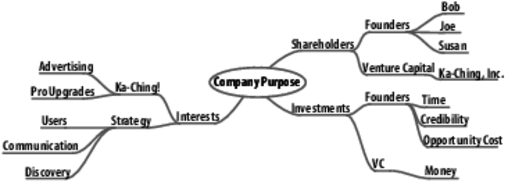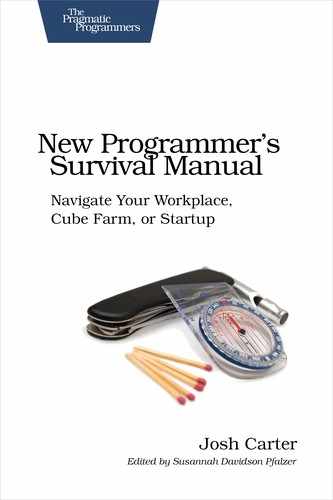| Tip 29 | Put Yourself in the Company’s Shoes |
 | [Black Belt] Once in a while, you’ll want to mentally check in with the company’s big-picture goals. Do you understand why and where it’s going? |
Let’s say you’ve joined a company that’s setting out to change the world. When your product ships, it’ll revolutionize the way people communicate, keep track of their kids, and do their laundry. That’s fine and good, but your product is not the underlying reason the company exists.
“Why are we here?” is perhaps the biggest of big-picture questions. Its answer, however, is simple: the role, the underlying raison d’être, of any company is to protect the investment and interests of its shareholders.
You may think, “Am I merely the tool of greedy capitalist investors?” Well, most likely, to a degree…yes. But before pledging your undying allegiance to Richard Stallman and free software, let’s back up and consider that the role stated earlier is true even for altruistic organizations.
Take a nonprofit organization like One Laptop Per Child (OLPC), whose mission is “to create educational opportunities for the world’s poorest children by providing each child with a rugged, low-cost, low-power, connected laptop with content and software designed for collaborative, joyful, self-empowered learning.”[47]
For shareholders in OLPC, they’ve put in money, time, and/or expertise. Protecting their investment means keeping OLPC afloat—OLPC needs to keep bringing in money so they can keep pumping out laptops. Protecting the shareholder’s interests means keeping OLPC true to the cause. The kids need laptops for learning; that’s what OLPC shareholders signed up for, so the organization can’t switch to One Toaster Per Child (even if the toaster runs NetBSD).
Now with a more-profit-the-better company, the role can be simplified to: ka-ching! ka-ching! ka-ching! The investors may not care if they’re investing in technology or investing in soap, so long as they get some ROI. Now we’re talking callous: is money your ultimate goal? If not, how do your interests match up with the shareholders?
Let’s say you’re truly the tool of greedy capitalists; you program so they can profit. There’s another side to the deal: they’re paying your salary. They’ve taken a risk by paying you good money so you can go program and maybe the resulting product or service will pan out.
Frankly, this can be a perfectly good deal. If you’re building the right product the right way and the rest of the business works out as planned, you get your satisfaction and the shareholders get their money. Everyone wins. And if the business doesn’t work out, it turns out you get to keep the money they paid you anyway. Both you and the shareholders move onto the next job.

Figure 12. Fictional company’s purpose
Actions
Let’s try to bring some of this abstract stuff closer to home. For this exercise, you may need help from your manager.
Let’s pick apart the statement that a company’s purpose is to protect the investment and interests of its shareholders:
-
Shareholders: who are they? If your company is publicly traded, they’re obvious: anyone who owns stock. Can you pick that apart any further and find out who has most of the stock? (This may take some research.) If your company is private, it still has stock; the difference is that its stock is not traded in an open market. The bulk of the stock is usually owned by the founders, angel investors, and/or venture capitalists.
-
Investment and interests: Now that you know who the shareholders are, can you figure out what it means to protect their investment and interests? The investment part is obvious—don’t waste their money. The interest part can be more complicated. (With a venture capitalist, it’s easy: ka-ching!)
A more complex case could be a partner company; their interest in your success may indirectly benefit another part of their business. For example, CPU maker AMD was an early sponsor of the One Laptop Per Child project. This was partly so OLPC would use AMD chips (ka-ching!) but also for the more strategic purpose of establishing AMD’s brand in developing countries.
-
Connect the dots: here’s where the rubber meets the road. Can you connect the dots from the shareholders and their interests to the product you’re making? Or to put it another way, how will the success of your product protect the investment and interests of the company’s shareholders?
Figure 12, Fictional company's purpose is a mind map for an imaginary company founded by a couple people (Bob, Joe, Susan) and funded by a venture capital firm. They’re doing a social networking website (isn’t everybody?) that they hope will make money from advertising and premium subscriptions.
In your map you could follow each branch a few more levels down. (To learn more about mind mapping as a tool for generating ideas and associations, see Pragmatic Thinking and Learning [Hun08].)
